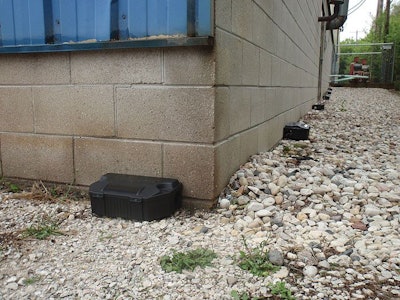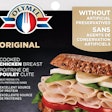
A good rodent control program is a vital part of a poultry farm’s biosecurity program. Rats and mice are important vectors of Salmonella, mycoplasmas, E.coli, Pasteurella and worms.
In addition to being biosecurity risks, rodents can have a significant impact on the economics of poultry farming because their gnawing and nesting behaviors can damage structures, and they can eat a lot of poultry feed. One rat consumes as much as 40 pounds of feed in a year, and a mouse can eat 4 pounds.
Rodent control team
Years of observation have helped Robert Rowland, a pest control consultant, reach the conclusion that “the key to the success of a rodent control program is for a company to form a small team of dedicated experts. There is much to learn about rodent behavior, as well as how to recognize and interpret their activities. Only then can an effective treatment program be implemented for a specific farm.”
This team is an investment, which is necessary to prevent serious biosecurity breaches. Ongoing training is important so all team members are up-to-date as staff turnover, vacations and other priorities can interfere with this important role.
Another expert, Lindsay Good, poultry marketing manager, Neogen, offers similar challenges to egg producers. She mentions: “Management needs to set proper expectations. We can’t eliminate rodents as an industry, but solid programs can keep them under control at acceptable levels. Both management and farm personnel need to understand the important role that rodent control plays in a biosecurity program. And they must allow time for and place value on proper execution of the plan.”
Keeping rodents out of the poultry house
So, where to begin? Initial steps to keep rodents out of the poultry house are to be sure that the outside building perimeter is rocked or mowed, eliminating hiding places. This also facilitates looking for evidence of rodent activity. Seal any opening — if a rodent can get its head through a hole, it can get in. Look for evidence of gnawing, droppings or burrows.
Clean up spilled feed and fix water leaks. Visit between dusk and dawn to observe rodent activity. Live traps are needed to monitor rodent activity level and calculate the rodent index as suggested by the Food and Drug Administration Salmonella Guidance.

Holes in poultry houses should be patched to prevent rodents from gaining access to the building. | Courtesy of Liphatec
Neogen offers customers a technological approach to identifying infestations using a proprietary night vision video system called Night Hawk. Equipment is set up throughout the house and controlled by a technician working from outside to record rodent activity. Why offer this costly service? Good explains that proper identification of the species and level of infestation allows the company to work with management to quickly decide on baiting strategies, along with other control measures, that will have the best chance for success.

The night vision system used to photograph these rats gives an accurate view of rodent activity in the poultry house. | Courtesy of Neogen
Selecting the proper rodent bait
Product selection is a challenge with so many options available in the market. Rodent baits generally are effective in controlling mice, Norway rats and roof rats, which are the major species in the U.S. Active ingredients are either anticoagulants or neurotoxins.
There are both first- and second-generation anticoagulants, with the main difference being the second generation only requires one feeding to consume a lethal dose. One neurotoxin, bromethalin, has a stop-feed action, meaning rodents stop eating after consuming the amount of product required to deliver a lethal dose.
Presentations include blocks, pellets, seeds/meals/grains, soft baits and liquids. Blocks and some other presentations are prepared with wax, which allows them to maintain their shape and integrity during hot summer months. These wax-containing products also are useful in damp areas or in the presence of high insect activity. Other good uses include areas where blocks are zip-tied to beams used as rodent pathways.
Baits using seeds, meals and grains offer good palatability and sometimes are formulated with scents that help attract rodents. Mice particularly enjoy hulling seeds used in these bait presentations.
Loose pellets are applied in the openings of outside burrows as they are less likely to be removed by rats. Between flocks, pellets or meals can be offered on paper plates for easy access. Some manufacturers offer two pellet sizes, which is important as mice show a preference for the smaller pellet.
Packets of pellets or meals are designed to be tossed in hard-to-reach areas such as attics. Chewable packaging also helps protect against damp conditions or insect infested areas.
Bait stations are highly recommended to prevent access by non-target animals. Stations generally are designed with rods to hang blocks and can also use other bait presentations. Care must be taken to ensure that product that might be dragged out would not be accessed by non-target animals.

Bait station rods are used to secure the bait and prevent its removal from the station. | Courtesy of Liphatec
Locating your bait stations
Placement of bait is extremely important as rodents prefer not to travel far from their nest for food. Roof rats are the most mobile (up to 300 feet); Norway rats will move up to 100 feet and mice only up to 30 feet. However, for best control, manufacturers recommend much closer station placement as rodents will most likely find an alternative food source closer to their nest. Bait station placement recommendations for mice range from eight to 15 feet apart, and from 15 to 30 feet apart for rats.
The first place to start placing bait stations is the outside perimeter of the building. Rodents like to nest in manure storage sheds as well as near cool cells in the summer. Moving inside, start at the top — if there is attic space, monitor and bait as needed. Be sure to consider mechanical rooms, breakrooms and closet areas. Finally, depending on the housing system, the interior needs to be baited and closely monitored for activity and bait refreshment.
Rotating poisons
Rotation is recommended to prevent resistance. Most companies recommend using product containing a quick-kill neurotoxin at least two months in the fall when rodents move indoors. Remaining months should be split between two different active ingredients in anticoagulant products (first generation diphacinone or second generation compounds such as brodifacoum, bromadiolone, difenacoum or difethialone).
A more recent introduction in the mix of products is Cannon, the first soft bait containing the neurotoxin bromethalin. This Liphatech product is claimed to be very palatable as it does not contain wax. Producers have confirmed palatability and consumption of this soft bait using side by side comparison trials next to blocks containing wax.
Neogen has recently introduced Decimax, which contains the second generation anticoagulant bromadiolone, in blocks and place-packs that feature grains and seeds appetizing to rodents. These follow last fall’s launch of a soft bait presentation that contains wheat flour, grain, lard and peanut butter flavoring.
Another new product in the market from BASF is Selontra, which contains cholecalciferol (Vitamin D3) as the active ingredient. This soft bait presentation has been shown to work well in anticoagulant-resistant rodent populations.
Producers must be vigilant to monitor consumption of baits and be ready to change a presentation due to preferences of the resident rodent population. There are differences in flavors and palatability between manufacturers. Also, some populations reject wax-containing blocks and pellets and should be treated with soft or grain-based baits. It’s important to study the ingredient list on the label as some manufacturers use wax in soft baits to help maintain a specific shape.
Rodent control is an important part of a layer operation’s biosecurity program and needs to have management commitment and resource allocation to be done properly. Suppliers offer years of expertise and should be consulted as a useful resource in developing and updating a program.
Read more: Designing an effective egg farm biosecurity program: www.WATTAgNet.com/articles/34784














